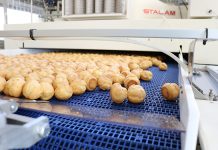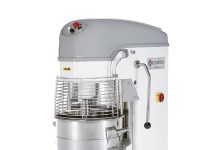 The use of raw material with good characteristics represents the key step for producing pasta of high quality. Nevertheless, the whole production chain greatly affects this quality: in the last decades, considerable progress has been made in identifying some phenomena that take place during processing, particularly in drying. In fact, the more advanced innovations in pasta manufacturing have been directed to optimize this process. Drying is the elimination of a liquid, normally water, from a substance or a solid body: if the water is inside it, the methods of drying will depend on the body’s physical and chemical properties, in particular on the characteristics of the body at issue. This is the case that concerns drying pasta, in fact drying is the most difficult and critical step to control in the pasta production process. The objective of drying is to lower the moisture content of the pasta from approximately 31% to 12-13% so that the finished product will be hard, retain its shape, and store without spoiling. However, the essential prerequisite for the pasta is not only to be dry, but also to have been dried properly; this means that, besides being dry, pasta needs to be “stable”: its internal moisture content must be remaining uniform. Since the outside surface of the pasta dries more rapidly than the inside, moisture gradients develop across the surface to the interior of the pasta. If dried too quickly, the pasta will crack, giving the product a poor appearance and very low mechanical strength. On the contrary, if the pasta is dried too slowly, it tends to spoil or become moldy during the drying process. When drying cycle has been successful, the pasta will be firm but also flexible enough so that it can bend to a considerable degree before breaking. So, the most significant physical states for pasta drying technology are the moisture and temperature of the air and the humidity and temperature of the product. Very briefly, drying pasta means modulating and properly controlling the evaporation of water from the product, using heat and ventilation. In general, the drying process can be realized by two different methods, that correspond to the plastic and elastic states of the product: the best results are obtained by applying a preliminary low drying temperature to reduce the pasta moisture, followed by a high drying temperature.
The use of raw material with good characteristics represents the key step for producing pasta of high quality. Nevertheless, the whole production chain greatly affects this quality: in the last decades, considerable progress has been made in identifying some phenomena that take place during processing, particularly in drying. In fact, the more advanced innovations in pasta manufacturing have been directed to optimize this process. Drying is the elimination of a liquid, normally water, from a substance or a solid body: if the water is inside it, the methods of drying will depend on the body’s physical and chemical properties, in particular on the characteristics of the body at issue. This is the case that concerns drying pasta, in fact drying is the most difficult and critical step to control in the pasta production process. The objective of drying is to lower the moisture content of the pasta from approximately 31% to 12-13% so that the finished product will be hard, retain its shape, and store without spoiling. However, the essential prerequisite for the pasta is not only to be dry, but also to have been dried properly; this means that, besides being dry, pasta needs to be “stable”: its internal moisture content must be remaining uniform. Since the outside surface of the pasta dries more rapidly than the inside, moisture gradients develop across the surface to the interior of the pasta. If dried too quickly, the pasta will crack, giving the product a poor appearance and very low mechanical strength. On the contrary, if the pasta is dried too slowly, it tends to spoil or become moldy during the drying process. When drying cycle has been successful, the pasta will be firm but also flexible enough so that it can bend to a considerable degree before breaking. So, the most significant physical states for pasta drying technology are the moisture and temperature of the air and the humidity and temperature of the product. Very briefly, drying pasta means modulating and properly controlling the evaporation of water from the product, using heat and ventilation. In general, the drying process can be realized by two different methods, that correspond to the plastic and elastic states of the product: the best results are obtained by applying a preliminary low drying temperature to reduce the pasta moisture, followed by a high drying temperature.
Plastic and elastic state of pasta
 On leaving the die, pasta normally has a moisture content of approximately 31-32% and is in a “plastic state”. The dough in its plastic state is deformed by the action of the die and the shape obtained will not be altered when the pressure of the die has stopped. Pasta can then undergo even powerful drying without this causing any internal tension and the risk of damage; also the deformation suffered due to extraction of the water will be maintained. When, proceeding with drying, the product’s moisture content falls further (22-18%), the state of the pasta changes from plastic to elastic. In this new state the product’s behavior is totally different: pasta subjected to stress deforms, but tends to recover its original shape as soon as the stress stops. Besides causing deformation, stresses can then bring about tension inside the product: if the tension comes within the product’s specific limit of elasticity, it can be absorbed precisely by its own elasticity. These two different situations of the physical state of the product determine the subdivision of the process into the two fundamental phase, called pre-drying and drying; at the end, it is essential to stabilize the product.
On leaving the die, pasta normally has a moisture content of approximately 31-32% and is in a “plastic state”. The dough in its plastic state is deformed by the action of the die and the shape obtained will not be altered when the pressure of the die has stopped. Pasta can then undergo even powerful drying without this causing any internal tension and the risk of damage; also the deformation suffered due to extraction of the water will be maintained. When, proceeding with drying, the product’s moisture content falls further (22-18%), the state of the pasta changes from plastic to elastic. In this new state the product’s behavior is totally different: pasta subjected to stress deforms, but tends to recover its original shape as soon as the stress stops. Besides causing deformation, stresses can then bring about tension inside the product: if the tension comes within the product’s specific limit of elasticity, it can be absorbed precisely by its own elasticity. These two different situations of the physical state of the product determine the subdivision of the process into the two fundamental phase, called pre-drying and drying; at the end, it is essential to stabilize the product.
Drying process
During the first phase, the moisture content of the product falls from 30-32% to 18-17%; the time this phase takes depends on a few variables: the temperature is the main. During pre-drying the water is extracted from the product with the highest rate. Also, this pre-drying technology makes it possible to gain different objectives: such as partial blockage of some enzyme activity and virtually total blockage of any product of fermentation; then it allows to uniform gluten distribution making possible the capacity of gluten to hold back the starch particles. Also, this pre-drying can decrease oxidation of the yellow pigments contained in the semolina and therefore give a brighter color of the dried product. Finally, this phase can provide a better shape stability and maintain the product’s capillarity, essential to redistribute the particles of water during the following steps of the process. The second step of drying must envisage alternating phases of water evaporation from the surface and of inside redistribution. Right now, ambient temperature and humidity normally decrease, clearly complying with the current temperature and moisture of the product. The speed of this phase is inevitably less than that of pre-drying, because of the structure of the product, passed on to the elastic state, has become more rigid, capillary action has decreased and so the migration of the remaining particles of water is slower. Putting these considerations into practice, there is the need to alternate phases of drying with phases of “re-hydration”. Thus means a long time, differently from the corresponding procedures implemented during pre-drying. The main aim is to avoid that the outside surface of the pasta dries up too much and too quickly, a result obtained by keeping the three components in functional balance: air temperature, air humidity, and ventilation flows.




your drying technology is very.we also use this methods.but, i have a question 1) how we can cobtrol the internal humidity of the dryer? 2) what are the advantages of using hot water during dough mixing? 3) at what temperature water suitable for dough mixing?
Comments are closed.